Welcome to our comprehensive guide on cultivating female flowers in gourds! Whether you’re a seasoned gardener or just starting your journey, this blog will provide simple and effective tips to increase the yield of female flowers. By employing accurate data and easy-to-read techniques, we will unravel the mystery behind promoting the growth of female flowers in your gourd plants. Get ready to learn to achieve the perfect balance, ensuring a burst of life and productivity in your gourd garden.
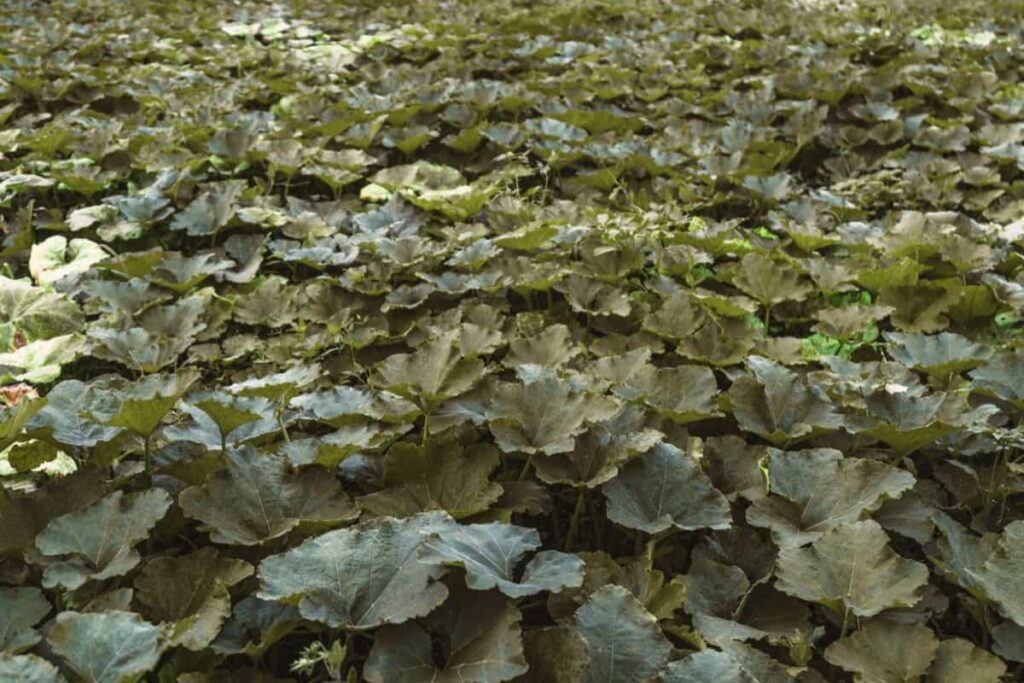
How to Encourage Female Flowers in Gourds
What are the Major Gourd Plants Where Female Flowers Are Needed?
Gourds, belonging to the Cucurbitaceae family, comprise different species that require female flowers for successful pollination and fruit development. In gourd plants, the female flowers hold the key to fruit production. Successful pollination occurs when pollen from the male flowers reaches the stigma of the female flowers. Among the major gourd, plants are
- Cucurbita pepo (Zucchini and Summer Squash): These gourds display separate male and female flowers on the same plant. The female flowers possess a swollen ovary at their base, representing the future fruit.
- Cucurbita moschata (Butternut and Winter Squash): Similar to Cucurbita pepo, C. moschata exhibits separate male and female flowers. The female flowers feature a distinctive bulbous ovary.
- Cucurbita maxima (Pumpkins and Hubbard Squash): This species exhibits distinct male and female flowers. The female flowers can be recognized by their thick and sturdy ovary.
- Lagenaria siceraria (Bottle Gourd): These gourds have different male and female flowers on the plant, with the female flowers characterized by their round-shaped ovary.
- Citrullus lanatus (Watermelon): Watermelon plants bear both male and female flowers, but the female flowers can be distinguished by their miniature immature fruit at the base.
Understanding the Importance of Female Flowers in Gourds
Female flowers play a role in the growth and fruiting of gourd plants. Unlike male flowers, which primarily produce pollen, female flowers house the ovaries that eventually develop into fruit. This process is pivotal for a successful gourd harvest. The importance of female flowers lies in their ability to facilitate pollination, allowing the transfer of pollen from male flowers to female ones.
This pollination process kickstarts fruit development, leading to a bountiful harvest of gourds. One significant benefit of encouraging female flowers is the enhanced fruit yield. With more female flowers successfully pollinated, the plant produces more gourds, increasing productivity. Additionally, female flowers ensure genetic diversity within gourd varieties.
In case you missed it: How to Encourage Female Flowers in Vegetables: Flower Increasing Tips and Techniques
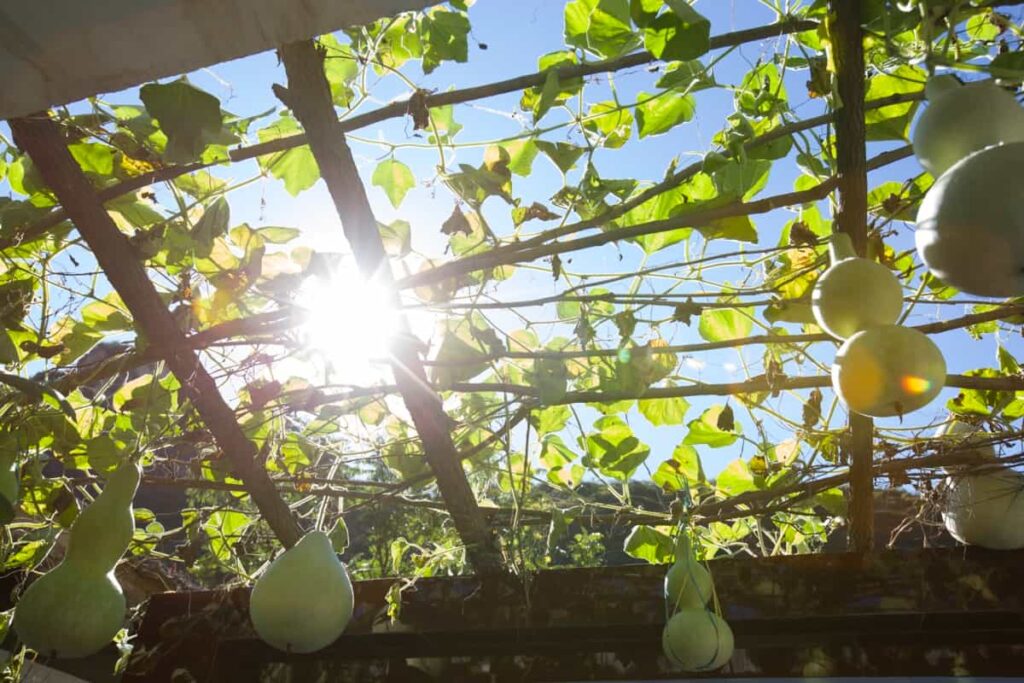
As different plants cross-pollinate, they create unique combinations, enriching the gourd gene pool and strengthening the overall resilience of the species. For instance, in the case of zucchini, encouraging female flowers can lead to an abundance of this popular and nutritious summer squash. Gardeners can optimize the female flower-to-fruit ratio and reap by providing the right growing conditions and following essential techniques.
Factors Affecting the Production of Female Flowers in Gourds
Internal and external factors influence female flower production in gourds. Understanding these factors can empower growers to optimize their yields. Internally, the plant’s age plays a crucial role. Young gourd plants initially tend to produce more male flowers, gradually transitioning to females as they mature. Nutrition is another critical factor; a balanced supply of nutrients, especially phosphorus and potassium, encourages the development of female flowers.
External factors, such as temperature and light, significantly impact gourd plants. Warm temperatures, ideally between 70-90°F (21-32°C), favor female flower production. Additionally, providing adequate sunlight, at least 6-8 hours daily, ensures robust growth and increased female flower formation. Pollination, facilitated by pollinators like bees, also influences the distribution of flowers.
Providing Optimal Growing Conditions for Female Flower Development in Gourds
- Temperature: Gourds thrive in warm climates with temperatures ranging from 71°F to 85°F (21°C to 29°C). Cooler temperatures can hinder flower development, while excessive heat can stress the plants.
- Sunlight: Gourds require full sun exposure for at least 6 to 8 hours daily. Place them in a spot with maximum sunlight exposure to encourage healthy flower growth.
- Humidity: Maintain a moderate humidity level of around 50% to 70% to prevent excessive moisture stress on the plants.
- Soil: Well-draining soil with a pH of 5.9 to 6.8 is ideal for gourd cultivation. Regularly check soil moisture to avoid overwatering.
- Pollination: Female flowers need proper pollination to set fruit. Encourage pollinators bees and butterflies to visit your garden.
- Fertilization: Apply balanced fertilizer during flowering to support female flower development.
In case you missed it: Ultimate Guide to 15 Best Fighting Rooster and Gamefowl Breeds
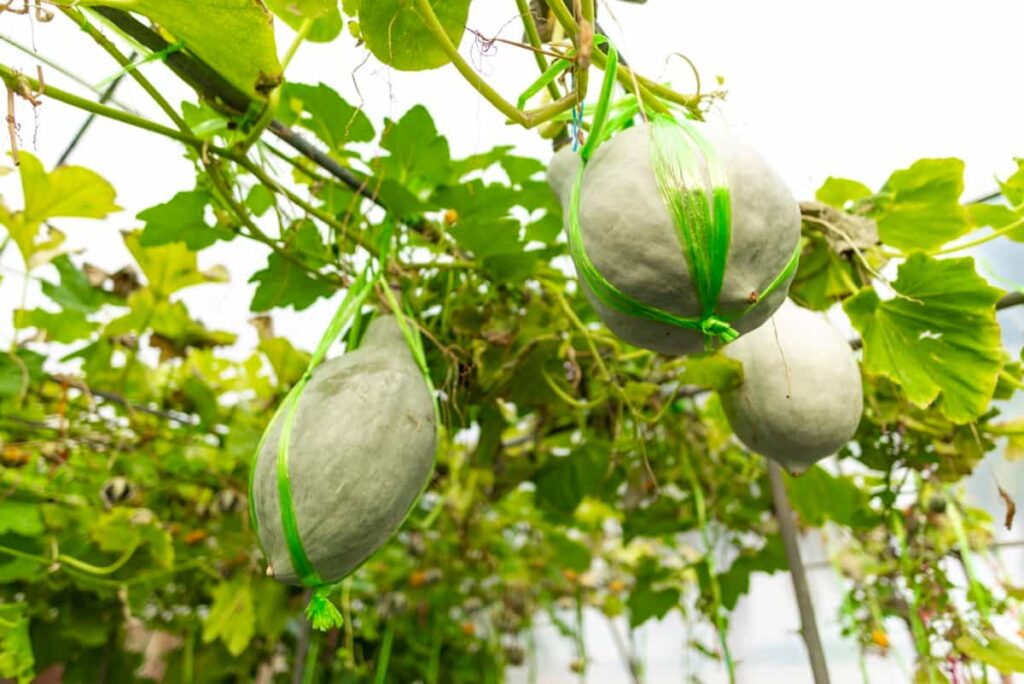
Selecting the Right Gourd Varieties for Female Flower Production
- Cucurbita pepo varieties: These gourds, including zucchini and yellow squash, are known for their prolific female flower production, making them an excellent choice for consistent yields.
- Cucurbita maxima varieties: Varieties like Hubbard squash and banana gourds also produce many female flowers, ensuring a steady supply of fruits.
- Cucurbita moschata varieties: Butternut squash and cheese pumpkins fall under this category, and they are prized for their high female flower count and delicious flavors.
- Cross-pollination: Some gourd types, like bottle gourds, may also both male and female flowers on the plant, allowing for self-pollination.
- Native species: Exploring traditional and native gourd varieties can also provide unique options well-suited to local growing conditions.
Proper Soil Preparation to Encourage Female Flowers in Gourds
Pollination plays a pivotal role in the female flower production of gourds, and it heavily depends on pollinators like bees, beetles, and butterflies. However, in kitchen and terrace gardens, the population of these pollinators is often limited, leading to a lower female flower ratio (around 10:1) compared to male flowers. To address this, hand pollination is a practical solution.
One can use a soft brush or cotton cloth to collect pollen from the male flower and gently transfer it to the female flower’s center for successful hand pollination. Another method involves placing the male flower directly onto the female flower in an inverted position and pressing it gently. It’s essential to perform hand pollination in the morning or evening when most gourd flowers bloom.
To increase female flowers, pinching the vine’s tip 30 days after seeding encourages the growth of side branches and more female flowers. Additionally, providing gourd plants with vermicompost and homemade nutrition every 15 days can boost yield. Continuous monitoring of female flower production and diligent hand pollination can produce abundant yields in your kitchen or terrace garden.
Implementing Adequate Nutrient Management for Female Flower Development in Gourds
- Timing: Begin fertilization when the gourd plants develop their true leaves, typically 2 to 3 weeks after germination. Continue fertilizing throughout the growing season.
- Nitrogen: During the vegetative phase, use nitrogen-rich fertilizers to encourage vigorous foliage growth and establish a robust plant structure.
- Phosphorus: As the gourd plants transition to the flowering stage, they switch to phosphorus-rich fertilizers. Phosphorus aids in promoting robust root systems and boosts flower formation.
- Potassium: Potassium is essential for overall plant health and flower development. Choose potassium-balanced fertilizers to support gourds during flowering and fruiting stages.
- Micronutrients: Gourds benefit from micronutrients like boron, zinc, and magnesium, which play vital roles in developing female flowers.
For commercial production, use well-balanced, slow-release fertilizers that provide a regular supply of nutrients throughout the growth cycle.
In case you missed it: How to Germinate Seeds: Techniques for Faster Germination of Vegetables, Flowers, Fruits, and Herbs

Controlling Temperature and Light Exposure for Female Flower Formation in Gourds
- Temperature: Gourds thrive in temperatures between 71°F and 85°F (21°C to 29°C). Too low temperatures can delay or inhibit flower formation, while extreme heat above 90°F (32°C) may cause flower drop. Keep your gourd patch warm but not scorching!
- Light Exposure: Gourds require at least 6 to 8 hours of direct sunlight daily for optimal growth. Lack of sunlight can result in weak and few female flowers. Ensure your gourd plants are placed in a sunny spot, or use artificial lighting if natural sunlight is limited.
- Timing: Female flowers typically appear 4-6 weeks after planting. Be patient and give your gourds time to establish before expecting flowers.
- Environmental Factors: Planting and Maintaining temperature and light levels, avoiding sudden fluctuations that could stress the plants.
Enhancing Pollination Techniques to Increase Female Flowers in Gourds
- Diverse Planting: Cultivate different flowering plants near your gourd patch to attract a wide range of pollinators. This diversity will encourage frequent visits, increasing the chances of successful pollination.
- Attract Beneficial Insects: Welcome pollinators like bees, butterflies, and hoverflies by creating pollinator-friendly habitats. Utilize native plants, provide water sources, and avoid using harmful pesticides that may deter them.
- Hand Pollination: Absence of natural pollinators, consider hand pollination. Gently transfer pollen from male to female flowers using a soft brush or cotton swab. Repeat the process daily during the flowering period.
- Time Your Pollination: Female flowers are receptive for only a short period each morning. Observe the flower’s appearance and timing to ensure effective pollination during its receptive stage.
- Shake and Vibrate: Gently shake the gourd plants or use a handheld vibrator near the flowers to simulate the buzz created by bees. This technique can enhance pollen release and transfer.
- Introduce Mason Bees: Mason bees are highly efficient pollinators and can be introduced to your garden. You can purchase mason bee houses or create your own to attract and retain these beneficial insects.
- Companion Planting: Plant compatible companion crops, such as marigolds or sunflowers, to encourage pollinators’ presence and create a welcoming environment for gourds.
- Optimize Environmental Factors: Maintain consistent soil moisture and provide ample sunlight to support pollinator activities and plant health.
In case you missed it: Banana Plant Care: Nutrients, Fertilization, and Protection from Pests and Diseases
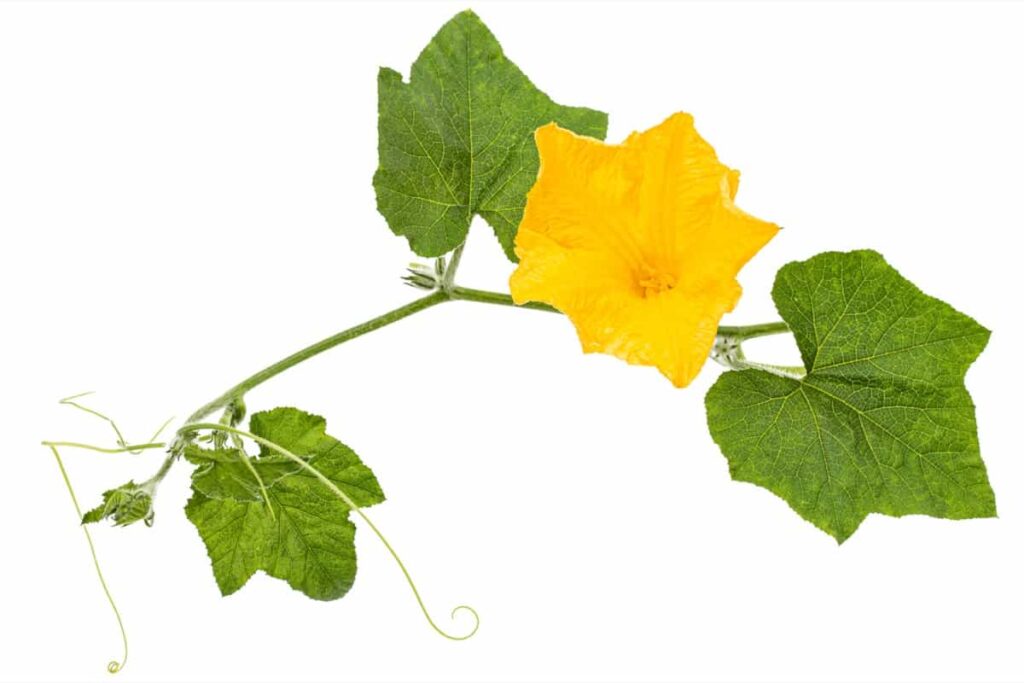
Utilizing Hormonal Treatments to Stimulate Female Flower Production in Gourds
Gibberellic Acid (GA3): This plant growth regulator can promote female flower development as a foliar spray. A concentration of 50-100 ppm is typically effective. GA3 works by stimulating cell elongation, enhancing flower formation.
Ethylene: Exposure to ethylene gas can encourage female flowers in gourds. A simple method involves placing ripe fruits, like bananas, near the plants. The ethylene released by the ripening fruits triggers flower development. Be cautious not to overexpose the plants to ethylene, as it may have adverse effects.
Cytokinin: Another hormone that aids in female flower production is cytokinin. It can be used as a foliar spray or through the soil. A concentration of 10-100 ppm is commonly used. Cytokinin promotes cell division and differentiation, which contributes to the development of female flowers.
Auxins: Although auxins primarily promote root and shoot growth, they can indirectly impact female flower production. By ensuring proper nutrient balance and overall plant health, auxins can create an environment conducive to female flower development.
Timing: Applying hormonal treatments at the right stage of plant development is crucial. Treatments during the pre-flowering stage or when the plants are starting to develop vines are often more effective.
Managing Pest and Disease Infestations for Healthy Female Flowers in Gourds
- Aphids: These small, sap-sucking insects can cause stunted growth and curling of leaves. Use insecticides or neem oil to control aphid populations.
- Squash Bugs: These pests feed on sap and transmit diseases. Handpick and destroy them, or use row covers to prevent infestation.
- Powdery Mildew: disease that appears as a white powdery coating on leaves, hindering photosynthesis. Apply fungicides or use a baking soda solution to control it.
- Downy Mildew: Another fungal disease that causes yellowing and wilting of leaves. Improve air circulation and use copper-based fungicides to manage it.
- Cucumber Beetles: These pests can damage both flowers and fruits. Apply pyrethrin-based insecticides to control their numbers.
- Bacterial Wilt: A serious disease that causes sudden wilting and eventual plant death. Remove infected plants promptly and avoid over-watering.
- Vine Borers: Larvae of moths that tunnel into the stems, causing wilting. Make vertical slits in the stem to remove the larvae.
Pruning and Training Techniques to Promote Female Flowering in Gourds
- Practice proper pollination: Ensure the presence of pollinators like bees and butterflies. If lacking, manually pollinate the flowers using a brush or cotton swab to transfer pollen from male to female flowers.
- Fertilize regularly: Apply a balanced fertilizer (e.g., 10-10-10 or 20-20-20) every two weeks during the growing season, following the recommended dosage to prevent damage.
- Use potassium-rich fertilizer: Boost flower production with a potassium-rich fertilizer (e.g., 0-0-60) once a month, enhancing plant resistance to diseases and stress.
- Proper watering: Water deeply weekly, especially during the flowering stage. Avoid overwatering to prevent root rot.
- Provide ample sunlight: Plant in a location receiving at least six hours of direct sunlight daily. In containers, move them to sunny spots.
- Prune the plant: Regularly remove dead or diseased leaves and branches. Pinch off the initial male flowers to stimulate more female flower growth.
In case you missed it: Banana Plant Care: Nutrients, Fertilization, and Protection from Pests and Diseases
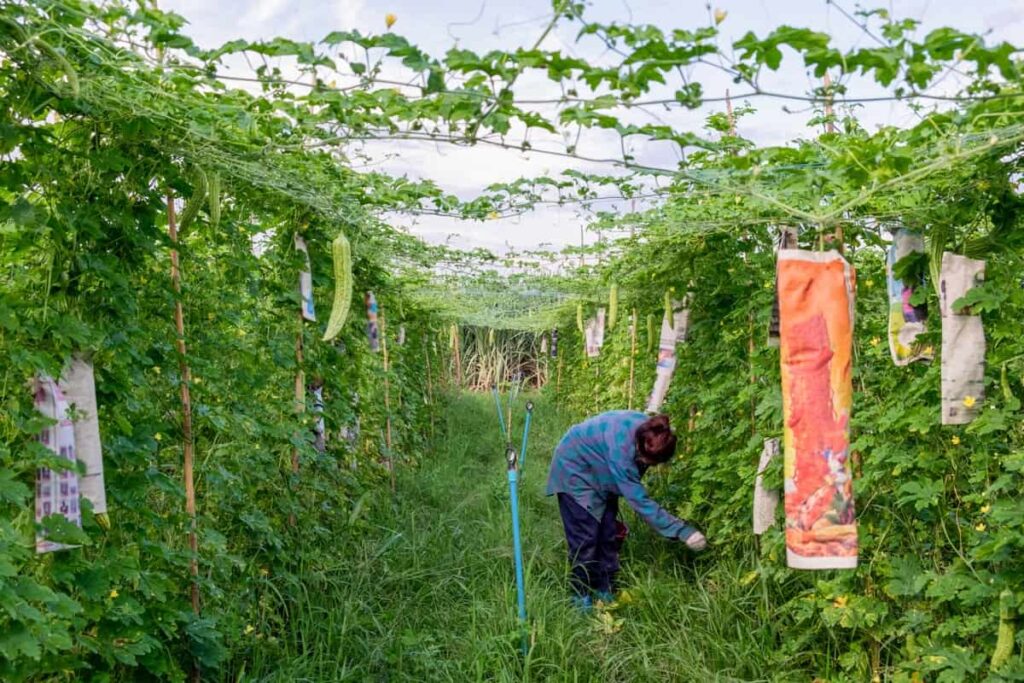
Conclusion
By implementing these effective tips and techniques, gardeners can successfully encourage the growth of female flowers in gourds. A thriving garden with abundant female flowers will lead to a plentiful harvest and a satisfying gardening experience.
- Sheep Farming Business Plan for Beginners
- Aquaponic Farming at Home: A Step-By-Step Guide
- Profitable Village Farming Business Ideas in 2024
- High-Yield Aquaculture: Fast-Growing Fish for Farming
- Effective Fish Pond Construction Techniques for Beginners
- Irrigation and Water Management in Pineapple Farming
- Blossom to Harvest: Mastering Flowering and Pollination in Papaya Farming
- Pig Fattening Essentials: From Selection to Sale for Beginners
- Raising Wagyu Cattle: A Complete Guide for Premium Beef Production
- Soil Types and Their Water Holding Capacity
- Optimizing Irrigation Schedules for Coconut Groves for Enhanced Yield
- Espresso Your Garden: Coffee Grounds for Healthier Acid-Loving Plants
- The Best Soil Mix for Snake Plants: How to Mix Your Own Snake Plant Soil
- Green Thumb Success: Expert Tips for Cultivating Greenhouse Beans All Year Round
- Bloom All Year Round: The Ultimate Guide to Indoor Hyacinth Care
- Eco-Friendly Gardening: How to Make Liquid Fertilizer from Kitchen Waste
- Ultimate Guide to Grow Anise in Pots: Explore Seed Propagation to Harvesting
- Guide to Raising Chester White Pigs: Discover Breed Facts to Growth Management
- Mastering the Elegance: The Ultimate Guide to Weeping Cherry Tree Care, Planting, and Maintenance
- Ultimate Guide to Planting Garlic in Grow Bags: Growing Strategies for Beginners
- How to Fix Spider Plant Leaf-Related Problems: Natural and Organic Remedies
- 10 Reasons Why Your Tulsi Plant is Shedding Leaves: Home Remedies and Solutions
- Optimizing Growth and Yield: The Advantages of Palm Bunch Ash Fertilizer
- Utilizing Neem Oil Extract as a Natural Pesticide for Hydrangea
- From Soil to Harvest: Various Ways in Which Farmers Can Use AI Tools
- Steps to Encourage and Induce Citrus Flowers: A Comprehensive Guide
- How to Fix Snake Plant Leaf-Related Issues: Natural and Organic Remedies
- Transform Your Garden into a Fragrant Oasis with Raat Ki Rani (Night Blooming Jasmine)
- Discover the Ideal Chicken Breeds for Philippine Farms
- How to Create a Poultry Egg Farm Business Plan for Profits
- Grow Lemon Cucumbers Like a Pro: Insider Techniques for Bountiful Yields
- Ultimate Guide to Caring for Your Pink Princess Philodendron: Tips for Thriving Variegation
- Areca Nut Profit Per Acre: Calculating Yield and Cost of Cultivation
- How Kaveri Chicken is Becoming a More Profitable Breed in Indian Backyards
- Transform Your Barn: 9 Steps to Convert a Horse Stall into a Chicken Coop
- Exploring Suffolk Sheep Disadvantages with Limitations and Challenges
